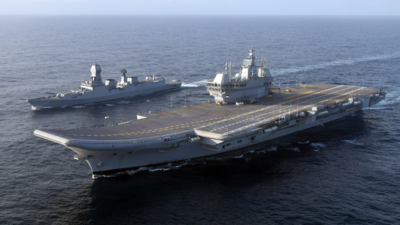Top Searches
- News
- India News
- INS Vikrant puts India in elite league with 5 other countries: 10 points
INS Vikrant puts India in elite league with 5 other countries: 10 points

NEW DELHI: Prime Minister Narendra Modi will commission India's first indigenous aircraft carrier INS Vikrant in Kochi on Friday.
The giant warship, housing state-of-the-art automation features, will contribute significantly towards enhancing India's maritime capabilities.
The commissioning of Vikrant is being seen as a significant step towards India's self-reliance in the defence sector.
On the cusp of a landmark event in India's naval history, here are 10 key points about INS Vikrant:
(With inputs from agencies)
The giant warship, housing state-of-the-art automation features, will contribute significantly towards enhancing India's maritime capabilities.
The commissioning of Vikrant is being seen as a significant step towards India's self-reliance in the defence sector.
On the cusp of a landmark event in India's naval history, here are 10 key points about INS Vikrant:
- INS Vikrant is the largest ship ever built in India's maritime history, built at a cost of Rs 20,000 crore
- It has been named after India's first aircraft carrier (which was in service from 1961 to 1997) that played a vital role in the 1971 war with Pakistan
- INS Vikrant vital stats: 262m long, 62m wide; displaces approximately 43,000 tonnes when fully loaded; maximum designed speed of 28 knots with endurance of 7500 nautical miles
- With its commissioning, India joins an elite league with US, UK, Russia, China and France- countries capabilities to indigenously design and build an aircraft carrier
- INS Vikrant designed by Indian Navy's Warship Design Bureau, built by Cochin Shipyard Limited
- Warship built using indigenous equipment and machinery supplied by India's major industrial houses as well as over 100 MSMEs
- Capable of supporting 30 aircraft; MiG-29K fighter jets, Kamov-31 and MH-60R multi-role helicopters, Advanced Light Helicopters and Light Combat Aircraft to be deployed on ship
- Has around 2,200 compartments, designed for a crew of around 1,600 that include specialised cabins to accommodate women officers and sailors
- Also has a full-fledged medical complex with latest equipment including physiotherapy clinic, ICU, laboratories and isolation ward
- Aircraft landing trials will begin in November, to be completed by mid-2023
(With inputs from agencies)
FOLLOW US ON SOCIAL MEDIA
FacebookTwitterInstagramKOO APPYOUTUBE
Start a Conversation
end of article









